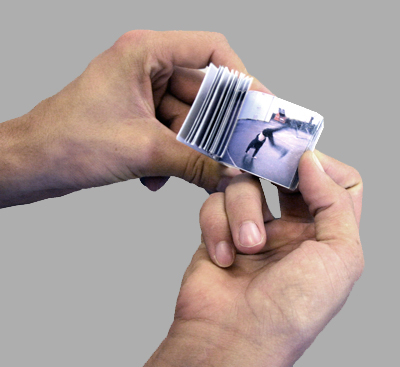EC Container 4
And it remains magic - I have a praxinoscope in the art room, with a galloping Muybridge horse, that, with a spin, still captivates, even in this age of digital wonderment.
It is hard to imagine just how magic this must have seemed to eyes unaccustomed to the moving image. The early innovators, such as Edward Muybridge, Charles-Émile Reynaud and Émile Cohl were showmen/magicians in the Victorian music hall tradition, but the magic may go back 1800 years to the Chinese inventor Ting Huan, hanging a device of transparent images over a lamp, the updraft from which spun the disk to create the illusion of movement.
The zoetrope as we know it was re-invented in 1833 by British mathematician William Horner, who called it the Daedalum, perhaps in reference to the Greek legend of Daedalus, the father of Icarus, said to be a craftsman of such skill that he could make statues that seemed to move. The name 'zoetrope' was coined by the American William F Lincoln, from Greek roots meaning 'Wheel of Life'. Lincoln took out a patent and marketed his device as a toy. Muybridge, with his zoopraxiscope, can claim ownership of the first commercial movie theatre.
I downloaded the code for this flash based zoetrope and modified it, with the idea of using it in school. It has been one of the inspirations behind the idea of creating iPhone and web based zoetropes, both projects that I am working on. I chose this sequence both because the figure might be me, and as reference to the walking/thinking that I have been doing as a part of this project.
The current generation of digital SLR and cameras take both still and moving images. Digital camera technology is blurring the edges between 'real time' and 'constructed time'. It is an appropriate time to look back at the roots of moving image, and the relation of the actual and the virtual, a sense of what is real and what is illusory. Reality is infinate; we can only hope to grasp the merest fleeting glimpse, and then we may only see what we think is there.
Sitting on a the BART on my way from San Francisco to San José last summer; a slatted fence briefly animates the scene behind. A fleeting glance.
Many years ago I took a school group to an exhibition of automata, sponsored by Terry Gilliam. One of the exhibits was a large wheel with white wax figures around its circumference, 4 or 5 cms tall. A strobe lit the figure nearest, and when the wheel rotated, this figure walked, a perfect walk cycle, with bobbing head and swinging hips. While seeing the animated, 'living' figure, the viewer was simultaneously aware of all the static statues in the shadows.
Toshio Iwai is an artist who has investigated the artistic possibilities of the zoetrope, and there is the wonderful The Life Size Zoetrope, Mark Simon Hewis. (links to both artists are in my tumblr site).
Flip books also have a simple magic to them. The flip book, flick book, kineograph, kinetograph or folioscope, was first patented in 1868 and predates the movies. It encapsulates the very essence of animation. I was hooked following a school outreach visit from the University of the West of England. Carinna Parraman, a research fellow at UWE’s Centre for Fine Print Research was running the project on the roots of Animation.
Muybrige was a fan of the flip book, as is the contemporary artist Julian Opie. In anticipation of my collaboration with the CFPR in the coming year, I have been collecting flip books. My favourite reproduces the crop duster sequence from Hitchcock’s film North by North West, capturing a defining moment of action, a peak in the narrative.
Both flip book and zoetrope depend on the simplest reciprocating movements, which is both constraint and creative challenge.

EC Container 5
